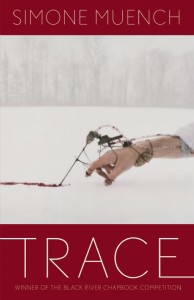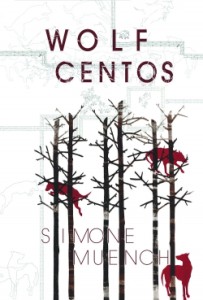 Book Title, Press, Year of Publication:
Book Title, Press, Year of Publication:
Trace, Black Lawrence Press, 2014 (comprised of wolf centos as well).
Wolf Centos, Sarabande Books, 2014.
Synopsis: These are poems engaging the 4th century cento form, drawing on the wolf as their rhetorical spine.
What do you think makes your book (or any book) a “project book”?
It is a two-pronged project book in that a) all the poems are centos (a remix form that gleans pre-existing texts in order to compose new texts from found material, and b) all the poems have wolves in them, a la the opening quote of the book: “All the poetry has wolves in it, Pam.”—The Doors screenplay.
 Why this subject (or constraint)?
Why this subject (or constraint)?
I’m fascinated with both the cento form, which I think has been overlooked and underutilized, as well as being beholden to Larry Levis’s notion that when animals—and in my case, the wolf—appear in poems, “they are often emblems for the muteness of the poet, for what he or she cannot express, for what is deepest and sometimes most antisocial in the poet’s nature.” One of the lines from the Wolf Centos,“I have lost my being in so many beings” (Sophia de Mello Breyner), is a great summation of the whole cento approach. By using both the cento as well as figure of the “wolf,” I am able to create a collective I instead of a singular I; and through the constraints of the cento, its recombinant nature of recycling and reconfiguration, the poems are able to pay homage to influences and predecessors while beginning the conversation anew. Ultimately, I hope that these centos will offer a rendition of a text not yet available, and that their creation still honors and expands collaboration while showcasing that the cento can exist as a significant form in the landscape of contemporary poetry.
Are you comfortable with the term “project book”?
I’m not a one-word adjective gal as I find that single adjectival descriptions are sometimes employed to make diminutive what one does, a reduction technique, e.g.,” “woman poet,” “regional writer,” “erotic fiction,” etc.; thus, I frequently have the impulse to side-step them.
While certain adjectives are certainly more devaluing than others, and “project book” doesn’t have the heft of dismissal as my previous examples, I still find it delimiting as the word “project” has pejorative connotations in the same manner as “arts & crafts” or “mid-career poet.” Some may even be averse to reading “project books” in that they conceive that the “project” will somehow override “organic imagination” and “authorial integrity” whatever those two things may be. . . Unfortunately, I don’t have a succinct, alternative term at the moment, though I prefer the idea of a book of peculiar inquiry—with “peculiar” meaning both “strange” and “distinctive.”
Was your project defined before you started writing? To what degree did it develop organically as you added poems?
Yes, in that I knew I wanted to write a series of centos circling around the figure of the wolf. I originally had in mind a chapbook-length collection, which ended up as Trace (Black Lawrence Press). However, I realized I was too obsessed with the form to stop writing centos, especially since I’ve always been indebted to the concept of catching text instead of just pitching text, to paraphrase Jack Spicer. I also find that the process of constructing a cento is parallel to how I compose a “non-appropriated” poem. “Non-appropriated” is in quotes because I often think all poetry is a citational art—a series of quotations that have become ghosted—sometimes we just allow for those citations to be showcased more prominently. When I’m writing non-cento poems, they also tend to be composed in a patchwork fashion, as I never write linearly from a-to-z; instead, I sift through various notes and writings, looking for patterns of images and ideas that I then reshuffle repeatedly, focusing on odd collisions and surrealist encounters, until something doesn’t bore me.
Did you allow yourself to break your own rules?
I find it’s important to allow for flexibility in most things you do; however, part of the delight of applying poetic stipulations is the challenge of working within the constraints you’ve set forth. But, yes, I did approach the cento form with some flexibility in that I didn’t adhere to original punctuation. Additionally, I frequently constructed from line fragments instead of complete lines. That being said, I always maintained the integrity of the fragment phrase, never adding any material of my own. Instead of conceiving the cento process as one in which you stack line upon line like a brick layer, I considered it to be a fluid process, weaving lines together to create a more holistic language tapestry that is both collaborative and my own.
How important was it for you that each poem could “stand on its own” or that the poems should rely on other poems in the book, or on the premise of the project itself, to succeed? What challenges did this present for you when writing single poems or structuring the book overall
Both/And. One of the conversations I had with my editor revolved around the repetitive titling of “Wolf Cento” for each poem. I realize that many may see it as redundant, but, for me, it is necessary because it creates a frame for each poem that adds both elegance and incantation, as well as speaks to the obsessiveness and recursivity of the manuscript. Additionally, it marks for the reader that though these poems are in dialogue with one another, they are also autonomous and singular. Finally, the unchanging nature of the title should invite or provoke readers to contemplate how each poem interprets the title differently. So, yes, I want each poem to “stand on its own” while concurrently conversing with one another, just as the lines themselves are in dialogue with one another.
After completing a project, how did you transition into writing something new? What are you working on now? Another project?
After completing Wolf Centos, I found myself wanting to maintain a sense of collaboration in a similar manner to my cento-making. For me, the centos were sustaining dialogues with other writers; in addition, they were tributes, allowing me to pay homage to a range of writers, bringing them forth again in the world in conversation with other writers, while providing new systems of imagery and ideas. Because of my belief that poetry is ultimately a “call-and-response art” and my attraction to found material, palimpsestic texts, and homage and salutation, I turned to a series of multi-voiced sonnets, co-written with San Francisco poet Dean Rader, for my next enterprise after Wolf Centos. We titled them the Frankenstein Sonnets (though that title may change to Suture). We refer to them as such because of the process of construction: we take a line from a published sonnet, using that appropriated line as the generating substance—a strip of flesh if you will—that we then graft our own lines too, growing them collaboratively stanza by stanza.
What advice can you offer other writers, particularly emerging writers or poetry students who may be using the project book as a guiding principle for their own work?
Well, the most obvious, and perhaps tired advice, is to read: read with attention and absorption, not just within poetry but beyond—science-fiction, world history, art criticism, comic books, film theory, science facts, the dictionary, _______________. I read serial killer novels and the horror boards at IMDB, when I should be reading literature, but this material filters through my brain, and ends up as wonderful fodder for poems. For Wolf Centos, I read poetry across centuries and continents; I read translations of dead poets and living poets; I read single-authored collections and world anthologies. My point being, that for the undertaking of any book writing (project or not), reading is key, at least for me.
Also, engage in collaborative work with people, other poets and/or other artists. I’ve done several collaborations with poets Kristy Odelius, William Allegrezza, Philip Jenks, Dean Rader. Working with others allows for dexterity in your own writing, as well as creating an awareness of various writing tics. More importantly, collaboration often encourages you to take greater risks, expanding your writing in ways that wouldn’t necessarily occur without another voice to inspire, direct, and misdirect you into odd and marvelous spaces.
Final advice for writing project books: drink Prosecco and drop the f-bomb a lot.


